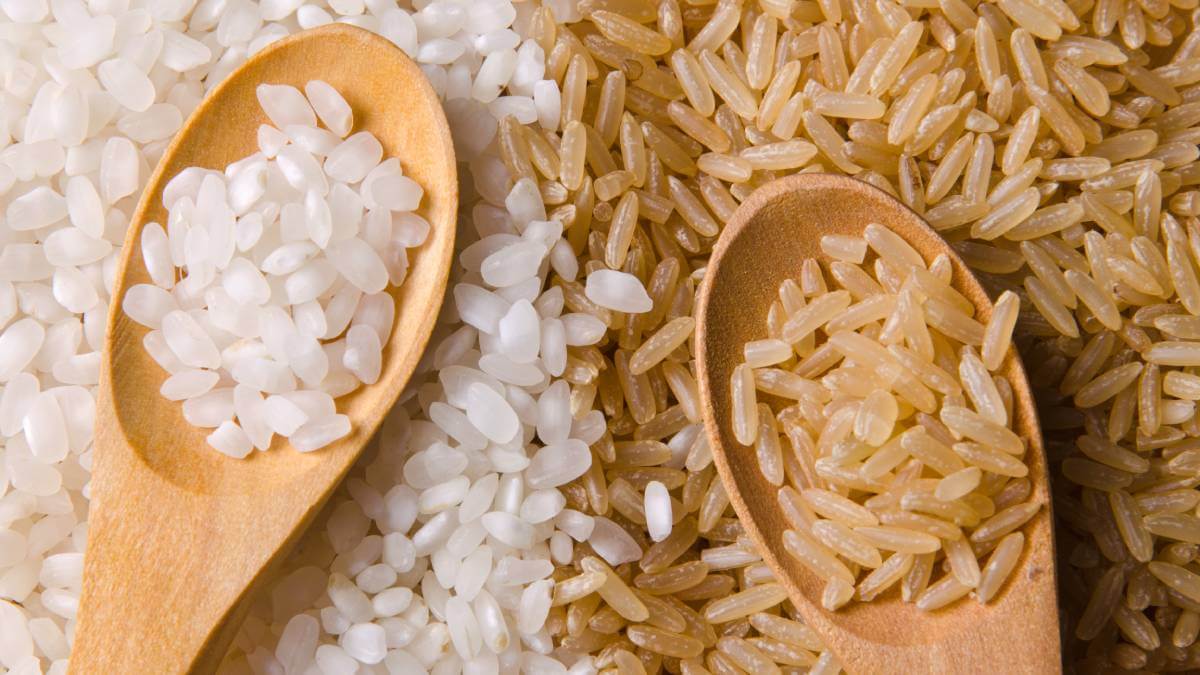Rice is a staple food for many people around the world, providing both a source of complex carbohydrates and a blank canvas for other flavours. It is a versatile grain that can be used in a variety of dishes, and it is a good source of nutrients.
There are more than 7000 varieties of rice and several colours, shapes, and sizes. The most common varieties we see in Australia are white rice and brown rice. White rice is the most commonly consumed type, but brown rice is also a popular option.
Differences between white and brown rice
White rice and brown rice differ in their appearance, nutrient content and in the way they are processed.
White rice is actually brown rice that has undergone a milling and polishing process. The rice grains are milled to remove the hull and the bran layer, leaving only the white endosperm. This process makes white rice more shelf-stable and less prone to spoilage, but it also removes important nutrients such as fibre and vitamins.
Because nutrients are lost in this process, B vitamins and iron are often added back in afterwards by food manufacturers.
Brown rice, on the other hand, is only milled to remove the hull, leaving the bran and germ intact. This means that brown rice retains more of its nutrients but is more perishable.
While brown rice gets its name from the natural colour of the grain, it’s important to note that whole grain rice also comes in colours such as black, purple and red.
Brown rice takes longer than white rice to cook, and once it’s cooked, has a nutty and chewy texture.
Negatives of brown rice
One potential downside to brown rice is that the bran layer contains phytic acid, which can prohibit the absorption of some nutrients.
Soaking it overnight before cooking can help mitigate the effects. It has been found that phytic acid could play a role in helping to prevent kidney stones so it’s not a reason to avoid brown rice altogether.
Brown rice also contains more arsenic than white rice – almost 80 per cent more in fact. But when you consider the benefits of brown rice, such as being linked to weight loss, reduced blood pressure and lower marker of inflammation, brown rice may still come out on top.
If you eat a lot of brown rice and you’re concerned about consuming harmful amounts of arsenic. try varying your choice of grain. Try some tasty quinoa, couscous or freekeh.
If you don’t want to cut down, cooking brown rice using a four-to-one water to rice ratio can remove some of the arsenic.
Negatives of white rice
White rice doesn’t typically offer as much nutrition as unrefined brown rice, but some food manufacturers enrich white rice with nutrients so check the packaging to know exactly what you’re getting.
Not only does it contain fewer vitamins, minerals and fibre than brown rice, but it also has a higher glycaemic index (GI) score. This means it can raise blood sugar levels more quickly.
If you have type 2 diabetes or are at risk of developing it, you may want to be careful about the amount of white rice you eat. A 2012 study found that greater consumption of white rice was associated with a higher risk of developing the disease.
Overall, brown rice seems to be a healthier choice than white rice, although white rice may be a better choice in some circumstances.
Certain dishes such as rice desserts, paella and risotto will only work with a white variety of rice. And it’s worth keeping in mind that people will only benefit from eating brown rice if it’s consumed as part of a healthy diet. There’s no use skipping fruits and vegies and trying to make yourself feel better by choosing brown rice over white.
And while it’s true that brown rice has more fibre than white, it’s not the grain that offers the most amount of fibre. For something different, make a dish with millet, quinoa, or bulgur – whole grains that are packed with fibre.
Reheating rice
Storing and reheating rice can entail a risk of food poisoning. To avoid this, you should only cook as much as you need for one meal.
If you need to keep rice for another meal, ensure you:
- cool it as quickly as possible, preferably within one hour
- keep it refrigerated for no longer than 24 hours
- check that the rice is piping hot all the way through when reheated
- avoid reheating it a second time.
Which rice do you prefer? Do you choose a certain rice for the health benefits? Let us know in the comments section below.
Also read: Save yourself from bad rice

